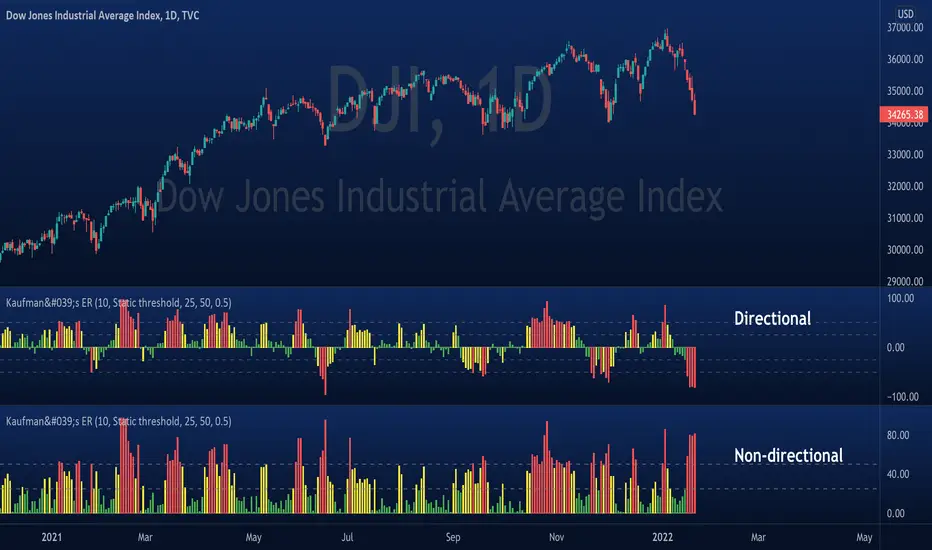OPEN-SOURCE SCRIPT
Aggiornato Kaufman's Efficiency Ratio Indicator

Kaufman Efficiency Ratio ("ER")
This ratio was developed by a systematic trader by the name of Perry J. Kaufman.
Formula
The formula is:
= A divided by B,
where:
Under default settings, closing price is used as source data, and the ER value is expressed in +ve/-ve signs (non-absolute), representing whether price had moved upward/downward over the period.
What this script does:
This script plots out ER and fills in the area beneath the curve with colors according to whether ER is classified as low/medium/high. There are two modes:
- Dynamic mode: low/medium/high is determined by ER value relative to it's mean +/- 'multiple' of standard deviation
- Static mode: low/medium/high is based on user defined thresholds
Applications:
- Can be used for identifying bullish moves in instances where price had already gone up steeply, but rests. If speculating that price will continually rise, then can enter during resting phase.
- Can be used to filter out choppy entry signals produced by existing trade strategies. If trying to enter during periods of consolidation, then ER should ideally be low. On the other hand, for mean reversion strategies, ER should be expected high.
This ratio was developed by a systematic trader by the name of Perry J. Kaufman.
Formula
The formula is:
= A divided by B,
where:
- A = Current closing price minus the closing price at the start of the lookback period
- B = Sum of differences between closing prices (in absolute terms) of consecutive bars over the lookback period
Under default settings, closing price is used as source data, and the ER value is expressed in +ve/-ve signs (non-absolute), representing whether price had moved upward/downward over the period.
What this script does:
This script plots out ER and fills in the area beneath the curve with colors according to whether ER is classified as low/medium/high. There are two modes:
- Dynamic mode: low/medium/high is determined by ER value relative to it's mean +/- 'multiple' of standard deviation
- Static mode: low/medium/high is based on user defined thresholds
Applications:
- Can be used for identifying bullish moves in instances where price had already gone up steeply, but rests. If speculating that price will continually rise, then can enter during resting phase.
- Can be used to filter out choppy entry signals produced by existing trade strategies. If trying to enter during periods of consolidation, then ER should ideally be low. On the other hand, for mean reversion strategies, ER should be expected high.
Note di rilascio
Can choose between three color modes: (1) Static, (2) Dynamic, and (3) No colorClarification: In Kaufman's book "Trading Systems and Methods", he compares price movements in a high noise market to the analogy of a "drunken sailor trying to walk a straight line". On the other hand, if a market displays no noise, price should be nicely trending straight. Following is an illustration of what this all means:
Note di rilascio
- switched to using histogram- added horizontal dash lines
Script open-source
Nello spirito di TradingView, l'autore di questo script lo ha reso open source, in modo che i trader possano esaminarne e verificarne la funzionalità. Complimenti all'autore! Sebbene sia possibile utilizzarlo gratuitamente, ricordiamo che la ripubblicazione del codice è soggetta al nostro Regolamento.
Read Faster & Learn Anything with Coral AI! getcoralai.com//?ref=dojiemoji
Declinazione di responsabilità
Le informazioni e le pubblicazioni non sono intese come, e non costituiscono, consulenza o raccomandazioni finanziarie, di investimento, di trading o di altro tipo fornite o approvate da TradingView. Per ulteriori informazioni, consultare i Termini di utilizzo.
Script open-source
Nello spirito di TradingView, l'autore di questo script lo ha reso open source, in modo che i trader possano esaminarne e verificarne la funzionalità. Complimenti all'autore! Sebbene sia possibile utilizzarlo gratuitamente, ricordiamo che la ripubblicazione del codice è soggetta al nostro Regolamento.
Read Faster & Learn Anything with Coral AI! getcoralai.com//?ref=dojiemoji
Declinazione di responsabilità
Le informazioni e le pubblicazioni non sono intese come, e non costituiscono, consulenza o raccomandazioni finanziarie, di investimento, di trading o di altro tipo fornite o approvate da TradingView. Per ulteriori informazioni, consultare i Termini di utilizzo.